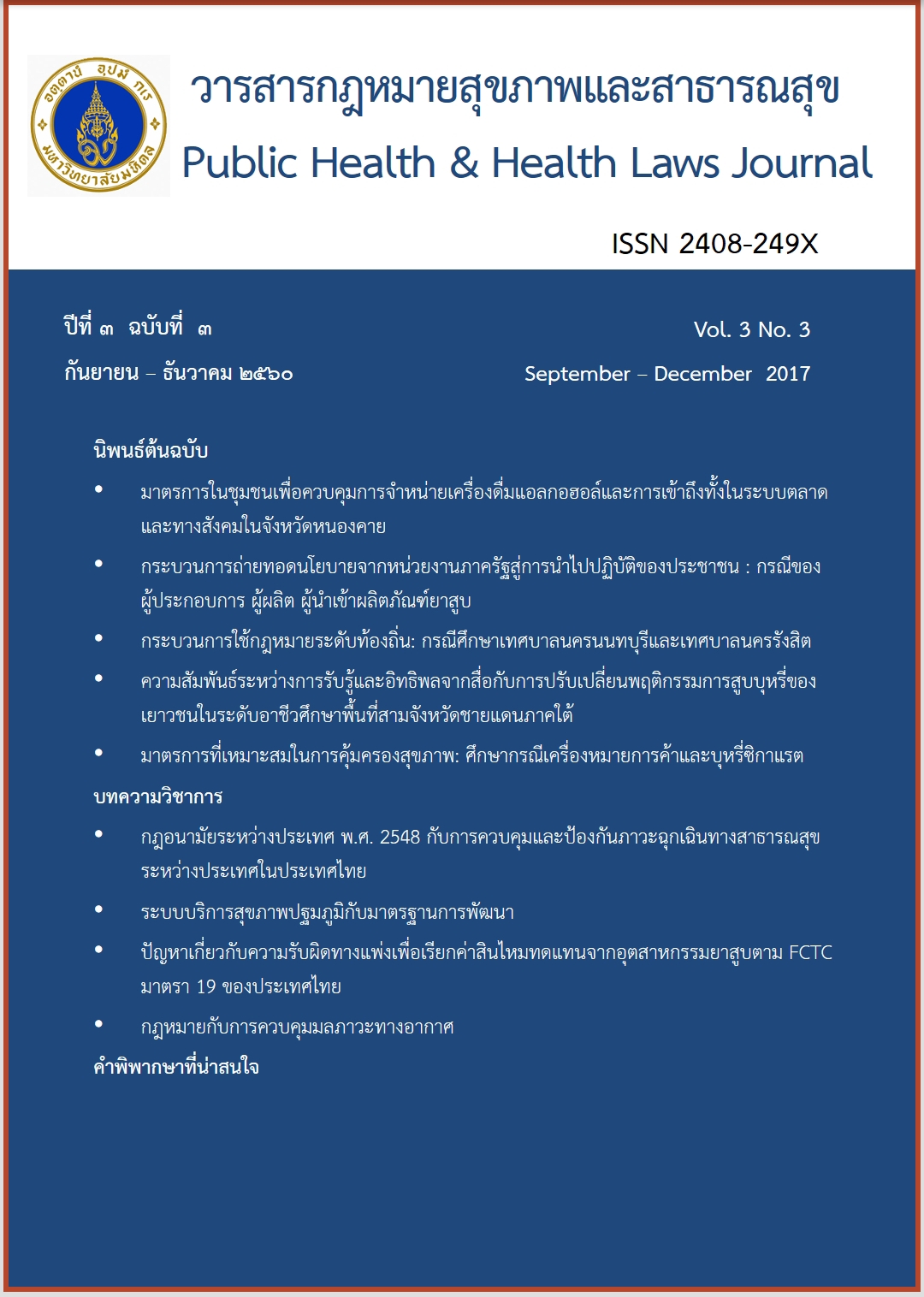Appropriate Measure to Protect Public Health: A Case Study on Trademark and Tobacco Products
Keywords:
Health Protection, Appropriate Measure, Trademark, Tobacco Plain Packaging Measure.Abstract
The research objective is to study proper legal measures in order to protect health of the people by controlling tobacco or cigarette products while not infringing on the intellectual property protection of which is the main point in analyzing how to draft efficient and effective Tobacco Products Control Act. This is because the implementation of the WHO Framework Convention on Tobacco Control gives the obligation to Thailand to enact the law relates to tobacco packaging.
The research found that the plain or colorless packaging measure which is the result of interpretation and implementation of Australian Law strikes a proportionate balance between intellectual property law and trademark, particularly the way in which the legislation is drafted and is under the scope of law both in the context of a right establishment and a specific performance being under provided exception. Both international and domestic law highlighted the importance of public health which leads to apply of appropriate legal measures which proportionate with the effected right, specifically, a trademark.
From the above-mentioned research findings, the author suggests that the Tobacco Products Control Act should be drafted under the principle of intellectual property law and trademark by providing the exception clause of trademark law. The amendment of the Tobacco Products Control Act shall be specified as an issuing of measures in order to protect health of the people under TRIPs agreement. Also, the Act should give a proper preparation period for tobacco and cigarettes companies due to its effect on entire products’ packaging.
References
จุมพล ภิญโญสินวัฒน์. (2552). หลักเหตุผลของการคุ้มครองสิทธิในทรัพย์สินทางปัญญา. ดุษฎีนิพนธ์ สาขานิติศาสตร์ คณะนิติศาสตร์ มหาวิทยาลัยธรรมศาสตร์.
จุมพล ภิญโญสินวัฒน์ และ ภูมินทร์ บุตรอินทร์ (2559). ประวัติศาสตร์และแนวคิดเกี่ยวกับทรัพย์สินทางปัญญา. พิมพ์ครั้งที่ 1. กรุงเทพฯ : คณะนิติศาสตร์ มหาวิทยาลัยธรรมศาสตร์.
ไชยยศ เหมะรัชตะ. (2555). ลักษณะของกฎหมายทรัพย์สินทางปัญญา (พื้นฐานความรู้ทั่วไป). พิมพ์ครั้งที่ 9. กรุงเทพฯ : สำนักพิมพ์นิติธรรม.
ณัฐกานต์ พงษ์พันธ์ปัญญา. (2558). การให้เหตุผลทางกฎหมายของหลักความจำเป็นในการปกป้องชีวิตหรือสุขภาพของมนุษย์ในฐานะเป็นข้อยกเว้นต่อหลักการของกฎหมายทรัพย์สินทางปัญญาระหว่างประเทศ: ศึกษากรณีบรรจุภัณฑ์แบบเรียบของผลิตภัณฑ์ยาสูบ. วิทยานิพนธ์มหาบัณฑิต สาขานิติศาสตร์ คณะนิติศาสตร์ มหาวิทยาลัยธรรมศาสตร์.
เลอสรร ธนสุกาญจน์. (2557). การบริหารจัดการสิทธิในทรัพย์สินทางปัญญาเกี่ยวข้องกับเทคโนโลยี. วันที่ 10 มกราคม 2558, จาก http://www.lerson.sc.chula.ac.th/bc/index.php/articles/tech-innovation/ipr-management.
เอื้ออารีย์ อิ้งจะนิล. (2555). กฎหมายว่าด้วยการจัดการทำซองบุหรี่แบบเรียบหรือซองบุหรี่แบบมาตรฐาน. วารสารนิติศาสตร์ จุฬาลงกรณ์มหาวิทยาลัย. 30(1): 49 - 70.
Amanda Michaels. (1996). A Practical Guide to Trade Mark Law. 2nd ed. London: Sweet and Maxwell Limited.
Peter Drahos. (1996). A Philosophy of Intellectual Property. Dartmouth Publishing Company Limited.
Karen I. Vaughn. (1978). John Locke and the Labor Theory of Value. Journal of Libertarian Studies. Vol. 2. No. 4. p. 311 - 326.
Mark Davidson. (2015). Why the TRIPS challenges to plain packaging will fail. February 22, 2015. http://www.mccabecentre.org/downloads/M_ Davison_TRIPS_for_website_word_format_-_1.pdf.
Downloads
Published
How to Cite
Issue
Section
License
Disclaimer and Copyright Notice
The content and information presented in articles published in the Journal of Law and Public Health Policy represent the opinions and sole responsibility of the respective authors. The editorial board does not necessarily agree with or assume any responsibility for the views expressed.
All articles, data, content, images, and other materials published in the Journal of Law and Public Health Policy are the intellectual property of the journal. Any individual or organization wishing to reproduce, distribute, or otherwise use the entirety or any part of such materials must provide proper citation.





